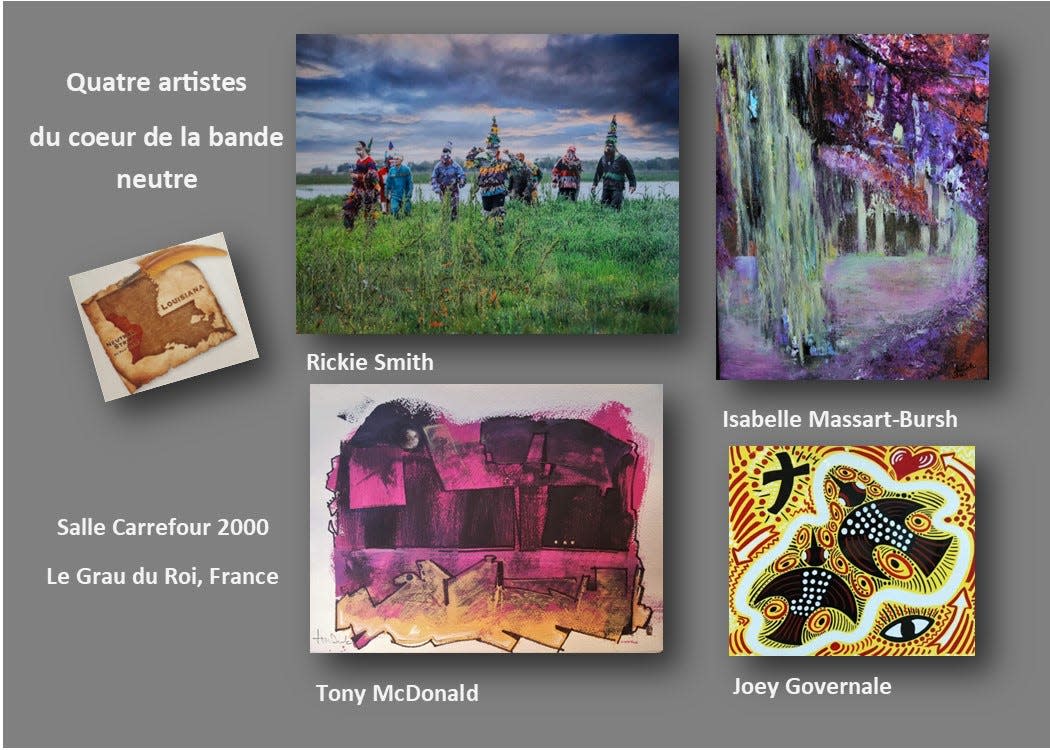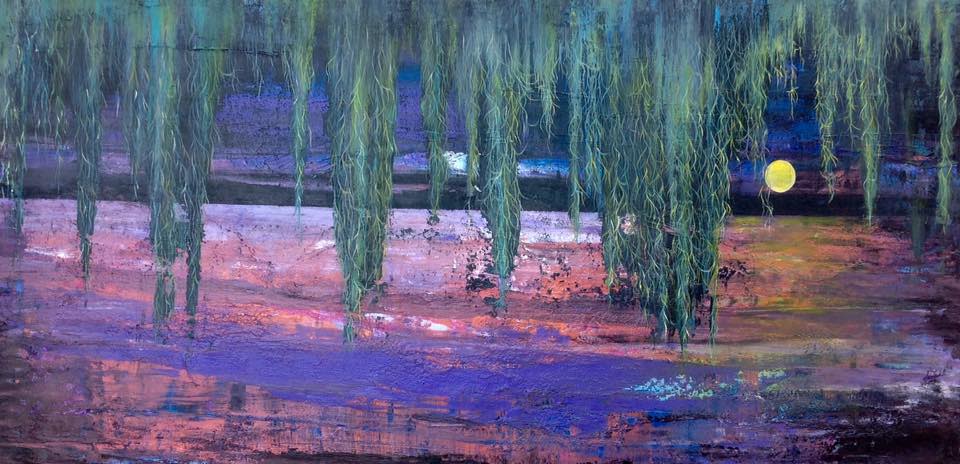Louisiana artists take No Man's Land exhibit to French gallery

Four Artists from the Neutral Strip, or No Man's Land, are using art to bring awareness to the colorful history, culture and landscape of a part of Louisiana with which many may not be familiar.
And they are doing it at an international level with an exhibit that opens July 23 at La Salle Carrefour 2000 in the city of le Grau Du Roi in France where it will stay until Aug. 13. The show was originally scheduled for 2020 but was canceled because of COVID.
"Quatre artistes du coeur de la bande neutre (Four Artists From the Neutral Strip)" features the work of Leesville artists Tony McDonald, Isabelle Massart-Bursh and Rickie Smith and Deridder artist Joey Governale.
"The exhibition hall is a big art gallery owned by the city of le Grau Du Roi," said Massart-Bursh who is currently in Europe. "They organize different exhibitions all year long."
"This exhibition takes place in Port Camargue, the second world's largest marina, after San Diego marina, which is a district of Le Grau-du-Roi," stated Robert Gourdel, council member for culture in Le Grau-du-Roi. "They are exhibited in one of the main cultural and exhibition places of the town, thanks to the municipal political will to bring art closer to what makes the very essence of the town - the sea, and the openness to the world that it underlies."
The history of No Man's Land
"When the Louisiana Purchase was finalized, there was the disputed strip of land that these parishes against the Sabine River that neither Spain nor France could decide who owned," McDonald explained about the area's history. He said Spain owned everything west of the Sabine while France owned Louisiana and the rest of the territory in the Louisiana Purchase.
"They didn't know what to do with this little strip," he said.
The present-day parishes that are in that strip are Allen, Beauregard, Calcasieu, Desoto, Natchitoches, Sabine and Vernon.
"And instead of going to war over it, they had a gentleman's agreement that neither of them would own it," he added. They were going to leave it alone and settle the matter later.
For three years, the area was not governed nor were there any laws so people who wanted to live without government interference flocked to the area, said McDonald.
More: Alexandria woman dives into music, moviemaking, theater as she journeys through grief
"That included thieves and robbers and cutthroats and pirates and people that just wanted to be out from government rule," he said. "And that's how it flourished for three years."
Then, said McDonald, the United States reached an agreement with France and it was made part of the Louisiana purchase in 1803.
How did the exhibit come about?
Massart-Bursh is from Belgium and vacations in Europe every summer to visit family, said McDonald.
"And her sister has a condo down in this town," he explained.
"I visited several exhibitions over the year and was impressed with the quality of their shows," said Massart-Bursh of La Salle Carrefour 2000. "We approached them with a portfolio of our idea of an exhibition and they were very receptive."
"They liked the meanings and they liked the idea of tying it to No Man's Land and the fact that were geographically similar," said McDonald.
Similarities in landscape
"Our Camargue landscapes are very similar to those of Louisiane," stated Gourdel. "It’s this closeness, this striking proximity, a delta which is a hostile landscape, domesticated by the hand of man, same varieties of plant and animal. That convinced our selection committee to accept this exhibition for part of this summer."
"This part of France called Carmague is a natural region located between the Mediterranean Sea and the two branches of the Rhône Delta," said Massart-Bursh. "The Camargue presents flat and varied landscapes. Between marshes, rice fields and wild lagoons you can discover wild horses, egrets and herons, as well as pink flamingos. Crayfish are not as tasty a meal as in Louisiana, but it is possible to discover them in some swamps."
Both have fragile ecosystems as well, she added.
"On 150,000 hectares of old swamps, the sea is gaining ground every day," she said of Carmague. "On average, the coast has been declining by 4 meters per year for half a century."
It's possible to walk into pine forests as you leave the coast, said Massart-Bursh. And heat and humidity are also present.
"The Camargue, a small Louisiane. Or Louisiane, a big Camargue," stated Gourdel. "A distant family ressemblance, but the same DNA. This is for us the meaning of this exhibition."

Originally from Belgium, Massart-Bursh came to Louisiana through the CODIFIL (Council for the Development of French in Louisiana) program to teach French. She resides in Leesville where she teaches art at Leesville Junior High School.
About the exhibit
"This part of Louisiana is where you get into the rolling hills before you get into North Louisiana so it's quite a bit different from everywhere else," said McDonald. "We've got flat agricultural land. We've got pine forests. These parishes were over forested and stripped of their pine forests and left as barren prairies and now it's all regrowing back."
His landscape paintings of the area will be featured in the exhibit along with those of Massart-Bursh and Governale.
The exhibit will also feature abstract paintings by Massart-Bursh. Governale will have graphic bird and landscape fine art images painted on aluminum. He also hand paints Louisiana-themed signs.
More: "The ELP" movie has plenty of familiar faces, places from Alexandria, Marksville
Even though Smith has images in the exhibit that were taken at the Mamou Courir de Mardi Gras which is outside of No Man's Land, he included them because it is a very unique part of Louisiana's state culture.
"I think it's going to help the people in France appreciate a part of what was brought from that country to Louisiana," said Smith. "And hopefully it's still recognized to this day in its most pure form."
As a group, he said they were disappointed that the first exhibit was canceled in 2020 but for Smith, it gave him the opportunity of extra time to make the decision of what he wanted to feature.
"I'm glad that we had the extra almost two years from the opening of the exhibit because it gave me an opportunity to go through a lot of my work and actually reevaluate what I wanted to be in the exhibit," said Smith.
"To have this exhibition of artists from Louisiana, from our distant French cousins and ancestors, who made Louisiana as they made the Camargue, to a population of 120,000 people who stays on vacation daily during the summer is an honor for us, and a small homage to them," stated Gourdel.

Partnership with No Man's Land Commission
The No Man's Land Commission has partnered with them and is providing funding, said McDonald. They will also send people to France for the opening of the exhibit to do cross marketing and work with the tourism industry.
"We are very existed and fortunate to be able to share our area of Louisiana with our French friends," said Massart-Bursh.
"It will be an educational thing also, talking about No Man's Land and the history of what went on over here," said McDonald.
They were not aware of the No Man's Land history but that is not surprising.
"I'm finding that very few people in Louisiana know about it," he said. "But we've raised awareness with this exhibit - I promise you."
The show will return in November and will be on exhibit at the Alexandria Museum of Art.
For more information, check out their Facebook page Four Artists from the Neutral Strip.
This article originally appeared on Alexandria Town Talk: Louisiana artists bring awareness of No Man's Land to French gallery

